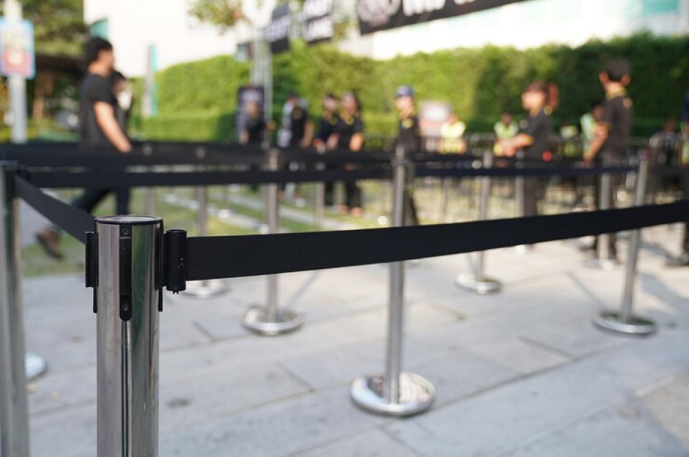Crowd control plays a vital role in running smooth and safe events. Whether hosting a concert, a trade show, or a product launch, organisers must provide clear guidance to participants and ensure that order is maintained. Choosing the right tool for that purpose makes a big difference. One common option is the queue pole, often seen in airports, banks, and exhibitions.
Some planners still use older methods, like metal barricades or chain-linked posts. These structures serve a purpose, but do they perform better in every case? This article compares queue pole vs traditional barriers for events across key areas: control, flexibility, safety, and style. Understanding their differences helps event managers make the right decision every time.
What Are Queue Poles and Traditional Barriers?
-
Queue Poles
Queue poles, also known as stanchions, consist of upright posts linked by retractable belts or ropes. They guide people through lines or prevent entry into certain zones. The modern design is clean, simple, and quick to set up. Queue pole rental options allow event organisers to bring in these tools only when needed.
-
Traditional Barriers
Traditional barriers include metal fences, plastic crowd barricades, or linked chain posts. These are heavier and often used outdoors or in high-security settings. They create solid physical divisions and block movement.
While both aim to control space and guide flow, they operate in different ways and suit different environments.
Comparing Crowd Control: Guidance vs Blockage
-
Queue Poles
Queue poles excel at guiding people, not stopping them. Their strength lies in forming organised paths for queuing or keeping people in designated zones. They create visual order without harshness. Guests feel directed rather than restricted.
-
Traditional Barriers
Traditional barriers serve better when a firm block is required. At outdoor concerts or races, they prevent crowd surges and separate performers from the public. However, they feel less inviting and may appear too rigid for events that aim for elegance.
Safety and Stability
Safety ranks high for any event planner. People must feel secure, and tools should not cause harm if misused.
-
Queue Poles
Modern queue poles come with weighted bases to remain stable, even in busy areas. Belts retract smoothly and avoid sharp edges. They pose minimal risk of tripping or injury. However, they should not be placed in windy outdoor areas unless secured.
-
Traditional Barriers
Metal or plastic barriers resist push and pressure. Their sturdiness helps in large outdoor gatherings. However, their bulk makes them harder to move. Poor handling may lead to bent sections or pinch points that cause injury.
Speed of Set-Up and Flexibility
Event logistics often require tools that can move and adapt fast. From set-up to teardown, every second counts.
-
Queue Poles
Setting up queue poles takes minutes. One person can carry, position, and link multiple poles without tools. If crowd flow changes mid-event, staff can reconfigure the layout with little effort.
-
Traditional Barriers
These barriers require more space, strength, and time to install. They suit fixed routes better than flexible ones. Their weight also limits how often they can shift once installed.
Aesthetics and Guest Experience
Style matters, especially at indoor events, luxury launches, or formal receptions. People notice what controls them. That detail forms part of the experience.
-
Queue Poles
Sleek, minimal queue poles blend into modern environments. Available in chrome, black, or matte finishes, they add polish to the setting. Rope or belt colours can match branding or theme. Their presence directs without dominating.
-
Traditional Barriers
These look functional, not refined. While suitable for large crowds or outdoor use, they rarely match interior decor. They also make some guests feel boxed in rather than guided.
Storage and Transport
After the event ends, the equipment must return to storage. The space and effort needed can affect future use.
-
Queue Poles
These poles are stored upright on wheeled racks. Belts retract into the poles, reducing mess. Their manageable size makes them ideal for short-term use. Many venues choose queue pole rental instead of purchase for this reason.
-
Traditional Barriers
Bulky and rigid, these barriers need trucks or dollies to move. They also demand larger storage rooms. Long-term use suits permanent venues more than short-term pop-up spaces.
Security and Durability
Some events need more than direction, they need firm control and resistance to damage.
-
Queue Poles
While strong enough for indoor use, queue poles may not deter rowdy behaviour. They serve best in settings where guests follow rules willingly, such as conferences or galleries.
-
Traditional Barriers
In high-energy or high-risk events, barriers hold better. Their solid build withstands crowd force, making them ideal for festivals, rallies, or large public ceremonies.
Situational Effectiveness: Where Each Wins
To simplify comparison, here’s a table showing when to use each solution based on event needs.
Best Use Cases by Feature
|
Feature |
Queue Pole |
Traditional Barrier |
|
Indoor Events |
Yes |
Rarely |
|
Outdoor Stability |
Needs weighting |
Strong in wind |
|
Quick Setup |
Excellent |
Slower |
|
Aesthetic Value |
High |
Low |
|
Heavy Crowd Control |
Not Suitable |
Strong |
|
Adjustable Layouts |
Easy to move |
Hard to shift |
|
Guest Comfort |
Feels open and calm |
Feels rigid or enclosed |
|
Short-Term Use |
Works well with rentals |
Costly to store and transport |
This breakdown helps organisers pick the right tool for the right job.
Real-Life Event Examples
1. Exhibition Centres
- Expos and trade fairs often feature queues outside booths or entrances. Queue poles create neat paths that respect space and move quickly. Their subtle design works well alongside signage and banners.
2. Concert Grounds
- In spacious venues with thousands of attendees, metal barricades are placed along the entrances and stage areas. They prevent crowd surges and offer visible control.
3. Luxury Events
- At red carpet affairs or product launches, velvet ropes strung between polished poles welcome guests with charm. Their clean lines enhance event decor while keeping movement under control.
4. Theme Parks
- Both systems appear here. Queue poles guide ride lines, allowing quick changes during the day. Fixed barriers protect off-limit zones or separate walking paths from vehicle routes.
Cost and Resource Considerations
Though we won’t list prices, the resource impact deserves note. Queue poles use space better and reduce staff effort. They allow reuse across different setups and styles. For events needing control without the burden of long-term ownership, queue pole rental remains a smart option.
Traditional barriers, while durable, need more transport and storage planning. They suit events where control beats aesthetics and where movement is minimal after set-up.
Conclusion
Effective crowd control does more than manage lines, it shapes how people experience an event. Balancing effective guidance with a robust defence, planners must match their tools to their goals.
Queue poles vs traditional barriers for events is not just a design question. It affects safety, comfort, and flow. A careful decision strengthens operations and makes the event more enjoyable for everyone involved.






